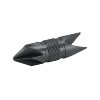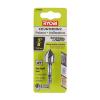Hoping I can get some guidance from you guys. I just finished my first reload. I read my Nosler book that came with my RCBS rock chucker twice over and followed the directions to the letter. I would like some extra reassurance that I did this right before I go to the range and blow my face off. I would appreciate if someone could read through the steps I took and tell me if I went down the right path or if I'm way off in the rhubarb.


The first thing I did was use my Lee depriming die to remove all of my primers. I then took the casings and cleaned them with my Frankford Arsenal media tumbler which uses water, lemi-shine, and stainless media. I tumbled for a total of 6 hours which I realize is overkill. After tumbling, I seperated the casings from the water and media, then rinsed them off. To try to prevent any contaminants from getting in the casings, I only used reverse osmosis water for the entire process. Again, probably overkill. After rinsing, I spread the casings out on a baking sheet and put them in the oven at 200 degrees for 2 hours to dry them off.
With the casings clean and dry, I used an RCBS full length resizing die to resize the cases. First I lubed them with the lube mat and lube that came with my kit. I ran the ram up until the shell holder made contact with the bottom of the die. This is where I have my first question. Is there rhyme or reason to how the height of the die is set? Is this just user preference? It seems that the only thing that matters is that the shell holder come in contact with the die. Any variance in the height of the die will only change the swing of the arm, right?
Next, I measured all of my cases. I found that all of my cases were 5-10 thousands shorter than spec. One of them was slightly over spec and I trimmed it down to exactly spec. Should I be concerned that most of my cases were under spec? Is it critical to have them within a thousands of each other and within a certain parameter of spec?
Next, I primed. I used the hand primer that came with my kit as opposed to priming on the press. I used CCI primers. This operation went smooth, no questions or concerns.
Next, I charged. I set my powder measure to throw just under the minimum load per my book. I then placed the powder on the scale and used a powder trickler to bring all of my charges up to spec exactly. I did this for every charge. I noticed that sometimes when I would throw a charge with my powder measure, the action would stick. I assume this is because the cylinder shape of my powder caused occasional jamming. Forcing the handle got it moving again. I then visually inspected all of my cases to ensure I did not miss a charge or double charge.
Next, I installed my RCBS bullet seating die. The first bullet that I seated did not seat the bullet below the groove in the bullet around the circumference. So I adjusted my height until that groove was below the neck of the case. Was it important to have this groove below the neck? After doing this, I found that my overall length was quite a bit under the maximum length, but was very close to some factory ammo that I had. What should I be taking into consideration for how far under the max overall length my round is? How far under is too far under? I also noticed when seating my bullets that some of the copper got shaved off the jacket of the bullet. Brass is harder than copper, so this makes sense to me, but is this normal?


My overall lengths were all within 5 thousands of each other. Should I be trying to target a consistent overall length?
The last thing I did was weigh all of my cartridges. I found that they were all within a grain of eachother. I thought this was very promising.
I did have one mishap. During bullet seating, I tried to set the depth of the bullet deeper by forcing the ram harder. This caused by case to crumple. I used a bullet puller to remove the bullet and powder, then deprimed. I wadded the powder in a paper towel and burned it outside. I did not know how else to get rid of it. The primer is sitting on top of my safe right now until I figure out what to do with it. I am thinking about putting it in the vice to detonate it and then throwing it away. The case is obviously junk.

I used the 90 grain e-tip bullets with the yellow highlighted minimum load

That's it. I think I am ready to go to the range and see if I did this right. Wish I had an old timer that could've watched over my shoulder the first time I did this, but unfortunately I don't. Any help from you guys is much appreciated.


The first thing I did was use my Lee depriming die to remove all of my primers. I then took the casings and cleaned them with my Frankford Arsenal media tumbler which uses water, lemi-shine, and stainless media. I tumbled for a total of 6 hours which I realize is overkill. After tumbling, I seperated the casings from the water and media, then rinsed them off. To try to prevent any contaminants from getting in the casings, I only used reverse osmosis water for the entire process. Again, probably overkill. After rinsing, I spread the casings out on a baking sheet and put them in the oven at 200 degrees for 2 hours to dry them off.
With the casings clean and dry, I used an RCBS full length resizing die to resize the cases. First I lubed them with the lube mat and lube that came with my kit. I ran the ram up until the shell holder made contact with the bottom of the die. This is where I have my first question. Is there rhyme or reason to how the height of the die is set? Is this just user preference? It seems that the only thing that matters is that the shell holder come in contact with the die. Any variance in the height of the die will only change the swing of the arm, right?
Next, I measured all of my cases. I found that all of my cases were 5-10 thousands shorter than spec. One of them was slightly over spec and I trimmed it down to exactly spec. Should I be concerned that most of my cases were under spec? Is it critical to have them within a thousands of each other and within a certain parameter of spec?
Next, I primed. I used the hand primer that came with my kit as opposed to priming on the press. I used CCI primers. This operation went smooth, no questions or concerns.
Next, I charged. I set my powder measure to throw just under the minimum load per my book. I then placed the powder on the scale and used a powder trickler to bring all of my charges up to spec exactly. I did this for every charge. I noticed that sometimes when I would throw a charge with my powder measure, the action would stick. I assume this is because the cylinder shape of my powder caused occasional jamming. Forcing the handle got it moving again. I then visually inspected all of my cases to ensure I did not miss a charge or double charge.
Next, I installed my RCBS bullet seating die. The first bullet that I seated did not seat the bullet below the groove in the bullet around the circumference. So I adjusted my height until that groove was below the neck of the case. Was it important to have this groove below the neck? After doing this, I found that my overall length was quite a bit under the maximum length, but was very close to some factory ammo that I had. What should I be taking into consideration for how far under the max overall length my round is? How far under is too far under? I also noticed when seating my bullets that some of the copper got shaved off the jacket of the bullet. Brass is harder than copper, so this makes sense to me, but is this normal?


My overall lengths were all within 5 thousands of each other. Should I be trying to target a consistent overall length?
The last thing I did was weigh all of my cartridges. I found that they were all within a grain of eachother. I thought this was very promising.
I did have one mishap. During bullet seating, I tried to set the depth of the bullet deeper by forcing the ram harder. This caused by case to crumple. I used a bullet puller to remove the bullet and powder, then deprimed. I wadded the powder in a paper towel and burned it outside. I did not know how else to get rid of it. The primer is sitting on top of my safe right now until I figure out what to do with it. I am thinking about putting it in the vice to detonate it and then throwing it away. The case is obviously junk.

I used the 90 grain e-tip bullets with the yellow highlighted minimum load

That's it. I think I am ready to go to the range and see if I did this right. Wish I had an old timer that could've watched over my shoulder the first time I did this, but unfortunately I don't. Any help from you guys is much appreciated.







